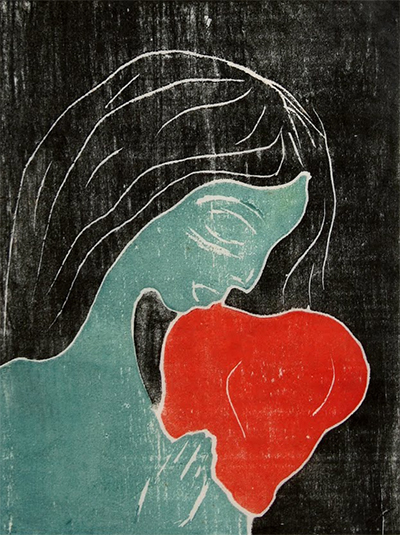The simplicity of Two Heart immediately strikes one as being unusual within the oeuvre of this artist. For love to be used as a theme is, of course, entirely typical of Edvard Munch, but the real lack of detail feels more like an abstract artist from perhaps several decades later.
The explanation can be found in the medium used, as this is actually a woodcut. For that reason he must have decided to keep his strikes of the chisel to a minimal and produce something which is abstract, but not by to such a degree that we cannot understand the composition. A young woman leans over, as if smelling a flower when in fact it is a heart. Her right hand appears with minimal detail from her own torso and her hair is roughly added, through scrapes left on the black background. The main part of her body is in a tone of green which works wonderfully against the bright red of the heart. The piece is dated at 1899, and during this period Munch was also producing a large number of lithographical prints, meaning he was experimenting with different mediums in order to both entertain himself as well as perhaps discover something new and interesting for the first time. He would even find stones on which to add artworks too.
The simplicity of this design suggests that Munch may have been simply working without too much of a plan for this piece, simply relaxing and allowing his mind to produce something from a freedom of thought. The colours would have been added afterwards and marks on the artwork suggest it was not kept with as much care as he might have done so with his traditional oil paintings. He may well not have realised that anything with his name would become so valuable in the years after his death, even items that he considered perhaps a study piece or merely a rough experiment.
The woodcut can be found in the Tel Aviv Museum of Art in Israel, where it normally sits alongside other classic artworks such as Untitled Improvisation V by Wassily Kandinsky, Contrast of Forms by Fernand Leger and The Chemin l'Ecluse and the Pontoise Bridge by Camille Pissarro. Incidentally, woodcutting is style of art which has received some interest from a number of notable European artists in the past. Perhaps best of all was Nuremburg master, Albrecht Durer as well as Lucas Cranach the Elder. At the time in the Northern Renaissance this was a particularly common art form and many intricate techniques had been handed down generations through various art schools and studios before generally being lost as the medium of woodcuts fell out of favour. Rhinoceros is perhaps the most popular of them all and instantly recognisable for those with an interest in this important period of European art.




